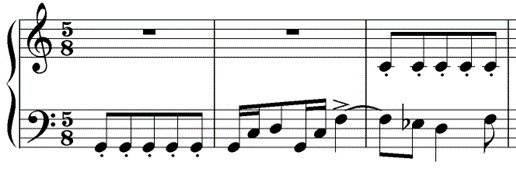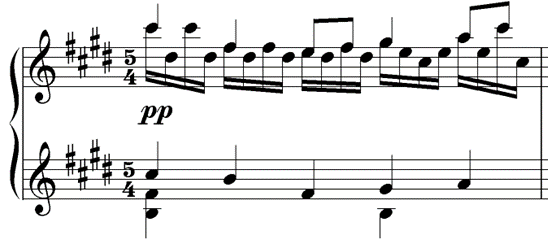Regular Time
All time signatures are either regular or irregular.
Regular time signatures have 2, 3 or 4 beats per bar, and the top number is only ever 2, 3, or 4 (simple time), or 6, 9 or 12 (compound time).
Irregular Time
The number of beats per bar in an irregular time signature can be anything except, 2, 3 or 4 beats per bar. The upper number is never 2, 3, 4, 6, 9 or 12.
Irregular time signatures are quite easy to deal with, because the upper number tells you how many notes to count, and the lower number tells you the type of note to count. Typical numbers you might find on top are 5, 7, 10 or 11.
- For ABRSM Grade 5 music theory, any type of irregular time signature might appear.
- For Trinity Grade 4 music theory, the time signatures you need to know are 5/8, 7/8 and 5/4. (7/4 appears at Trinity grade 7).
All irregular time signatures are simple – the beat subdivides into two.
- 5/8 = five quavers (8th notes) per bar
- 7/8 = seven quavers (8th notes) per bar
- 5/4 = five crotchets (quarter notes) per bar
- 11/16 = eleven semiquavers (16th notes) per bar
Irregular rhythms are found most often in more modern music, from the end of the 19th century onwards. They are rarely seen in music from the Baroque, Classical or early Romantic eras.
5/8
5/8 is an irregular time signature with five quaver (8th note) beats per bar.
The way notes are grouped together in 5/8 will normally show where the composer wants the emphasis to be. The bar could be divided into 3+2 beats, or 2+3 beats, for example. The beaming of notes in groups will also reflect where the composer wants the emphasis to be.
This is the beginning of a piano piece by Hindemith. Notice how the whole bar rest is also used in 5/8, for a complete bar of silence.

7/8
7/8 is an irregular time signature with seven quaver (8th note) beats per bar. 7/8 is quite an unusual time signature especially in very old classical music, but you might spot it in music written from the 20th century onwards, or in some folk music styles.
This Zambian folk song uses a variety of time signatures. This section alternates between 4/8 and 7/8.

5/4
5/4 is an irregular time signature with five crotchet or quarter note beats per bar.
5/4 works in the same way as 5/8 time, but with note values that are twice as long. The beaming or choice of note values will show where the composer wants any emphasis in the bar to be.
Here are two bars in 5/4 taken from the middle of the 3rd movement of Ravel’s Sonatine for piano. The position of the chords in the left hand shows that Ravel is thinking of a 3+2 pattern here.

7/4
7/4 is an irregular time signature with seven crotchet (quarter note) beats per bar.
This example is from the beginning of a piano piece by Alkan, a 19th century French composer., Flebile means weakly, or without strength. The way the notes are phrased, and the choice of note values with a long note on the 5th beat of the bar, shows that Alkan wants a 4+3 pattern here.
